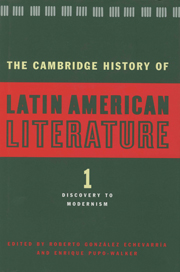Book contents
- Frontmatter
- Introduction to Volume 1
- 1 A brief history of the history of Spanish American Literature
- 2 Cultures in contact: Mesoamerica, the Andes, and the European written tradition
- 3 The first fifty years of Hispanic New World historiography: the Caribbean, Mexico, and Central America
- 4 Historians of the conquest and colonization of the New World: 1550–1620
- 5 Historians of the colonial period: 1620–1700
- 6 Colonial lyric
- 7 Epic poetry
- 8 Spanish American theatre of the colonial period
- 9 Viceregal culture
- 10 The eighteenth century: narrative forms, scholarship, and learning
- 11 Lyric poetry of the eighteenth and nineteenth centuries
- 12 Spanish American theatre of the eighteenth century
- 13 The nineteenth-century Spanish American novel
- 14 The brief narrative in Spanish America: 1835–1915
- 15 The Spanish American theatre of the nineteenth century
- 16 The essay in Spanish South America: 1800 to Modernismo
- 17 The essay of nineteenth-century Mexico, Central America, and the Caribbean
- 18 The gaucho genre
- Index
- Bibliographies
- References
12 - Spanish American theatre of the eighteenth century
Published online by Cambridge University Press: 28 March 2008
- Frontmatter
- Introduction to Volume 1
- 1 A brief history of the history of Spanish American Literature
- 2 Cultures in contact: Mesoamerica, the Andes, and the European written tradition
- 3 The first fifty years of Hispanic New World historiography: the Caribbean, Mexico, and Central America
- 4 Historians of the conquest and colonization of the New World: 1550–1620
- 5 Historians of the colonial period: 1620–1700
- 6 Colonial lyric
- 7 Epic poetry
- 8 Spanish American theatre of the colonial period
- 9 Viceregal culture
- 10 The eighteenth century: narrative forms, scholarship, and learning
- 11 Lyric poetry of the eighteenth and nineteenth centuries
- 12 Spanish American theatre of the eighteenth century
- 13 The nineteenth-century Spanish American novel
- 14 The brief narrative in Spanish America: 1835–1915
- 15 The Spanish American theatre of the nineteenth century
- 16 The essay in Spanish South America: 1800 to Modernismo
- 17 The essay of nineteenth-century Mexico, Central America, and the Caribbean
- 18 The gaucho genre
- Index
- Bibliographies
- References
Summary
Theatre in eighteenth-century Spanish America reflected the contradictions of what was, for most of the Hispanic realms in the New World, the last century of colonial rule. Like other aspects of colonial culture, theatre followed closely the dictates of the Spanish peninsula; accordingly, it tended to support and defend the colonial regime, while adhering to the anachronistic, late baroque repertoire that remained popular in Spain through most of the period. Yet the very conservatism of colonial theatre ensured its participation in the changes that peninsular drama underwent during the century, changes that corresponded to the reformist spirit of Neoclassicism and the critical perspective of the Enlightenment. It was inevitable that these changes would acquire their own kinds of momentum in the colonies, given the energy and diversity of the Hispanic realms beneath the official veneer of ideological and bureaucratic uniformity. Conformism in colonial theatre guaranteed change, and change moved irrevocably in the direction of individuation and disengagement.
Records of plays performed throughout the Hispanic world in the eighteenth century show a remarkable consistency of repertoires. The most popular playwright, through to the very end of the century, remained Calderón de la Barca (1600-1681), followed by other, lesser playwrights of the Calderonian school. Yet, by virtue of its close connection with the theatre of France, Hispanic theatre experienced a gradual and uneven acceptance of the neoclassic aesthetic: traditional Golden Age plays were often revamped according to the “new rules,” which demanded a closer adherence to the classical unities; tragedies and comedies of manners by Racine, Voltaire, Corneille, and Molière were translated or adapted for Hispanic stages, and original plays in the French neoclassic mold by Hispanic playwrights were written and performed.
- Type
- Chapter
- Information
- The Cambridge History of Latin American Literature , pp. 401 - 416Publisher: Cambridge University PressPrint publication year: 1996



